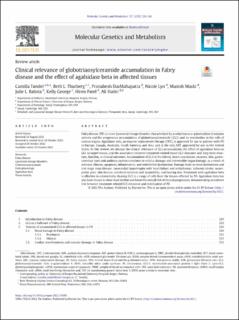Clinical relevance of globotriaosylceramide accumulation in Fabry disease and the effect of agalsidase beta in affected tissues
Tøndel, Camilla; Thurberg, Beth L.; DasMahapatra, Pronabesh; Lyn, Nicole; Maski, Manish; Batista, Julie L.; George, Kelly; Patel, Hiren; Hariri, Ali
Journal article, Peer reviewed
Published version

Åpne
Permanent lenke
https://hdl.handle.net/11250/3046484Utgivelsesdato
2022Metadata
Vis full innførselSamlinger
- Department of Clinical Science [2318]
- Registrations from Cristin [9791]
Originalversjon
Molecular Genetics and Metabolism. 2022, 137 (4), 328-341. 10.1016/j.ymgme.2022.10.005Sammendrag
Fabry disease (FD) is a rare lysosomal storage disorder, characterized by a reduction in α-galactosidase A enzyme activity and the progressive accumulation of globotriaosylceramide (GL3) and its metabolites in the cells of various organs. Agalsidase beta, an enzyme replacement therapy (ERT), is approved for use in patients with FD in Europe, Canada, Australia, South America, and Asia, and is the only ERT approved for use in the United States. In this review, we discuss the clinical relevance of GL3 accumulation, the effect of agalsidase beta on GL3 in target tissues, and the association between treatment-related tissue GL3 clearance and long-term structure, function, or clinical outcomes. Accumulation of GL3 in the kidney, heart, vasculature, neurons, skin, gastrointestinal tract and auditory system correlates to cellular damage and irreversible organ damage, as a result of sclerosis, fibrosis, apoptosis, inflammation, and endothelial dysfunction. Damage leads to renal dysfunction and end-stage renal disease; myocardial hypertrophy with heart failure and arrhythmias; ischemic stroke; neuropathic pain; skin lesions; intestinal ischemia and dysmotility; and hearing loss. Treatment with agalsidase beta is effective in substantially clearing GL3 in a range of cells from the tissues affected by FD. Agalsidase beta has also been shown to slow renal decline and lower the overall risk of clinical progression, demonstrating an indirect link between treatment-related GL3 clearance and stabilization of FD.
